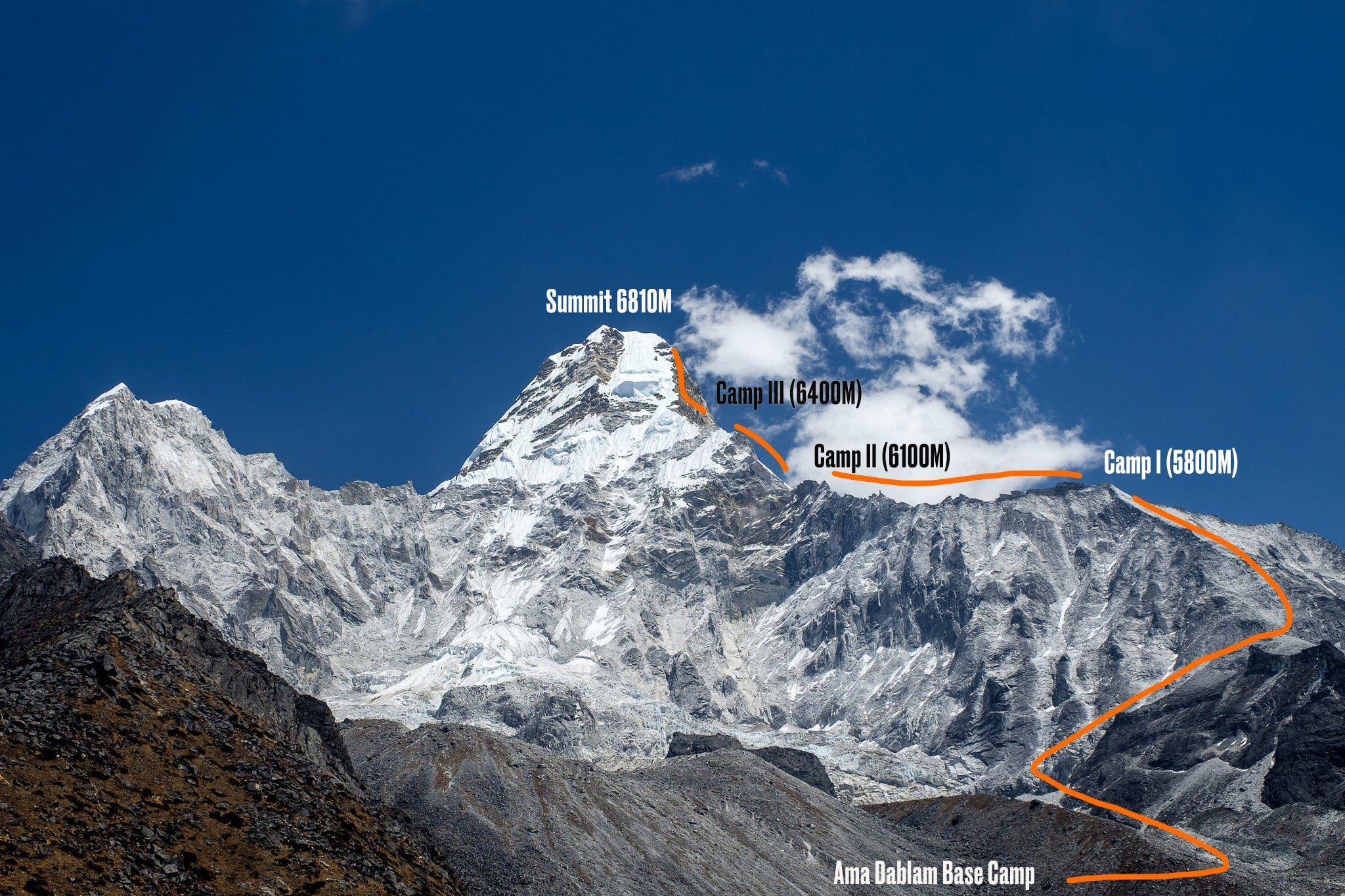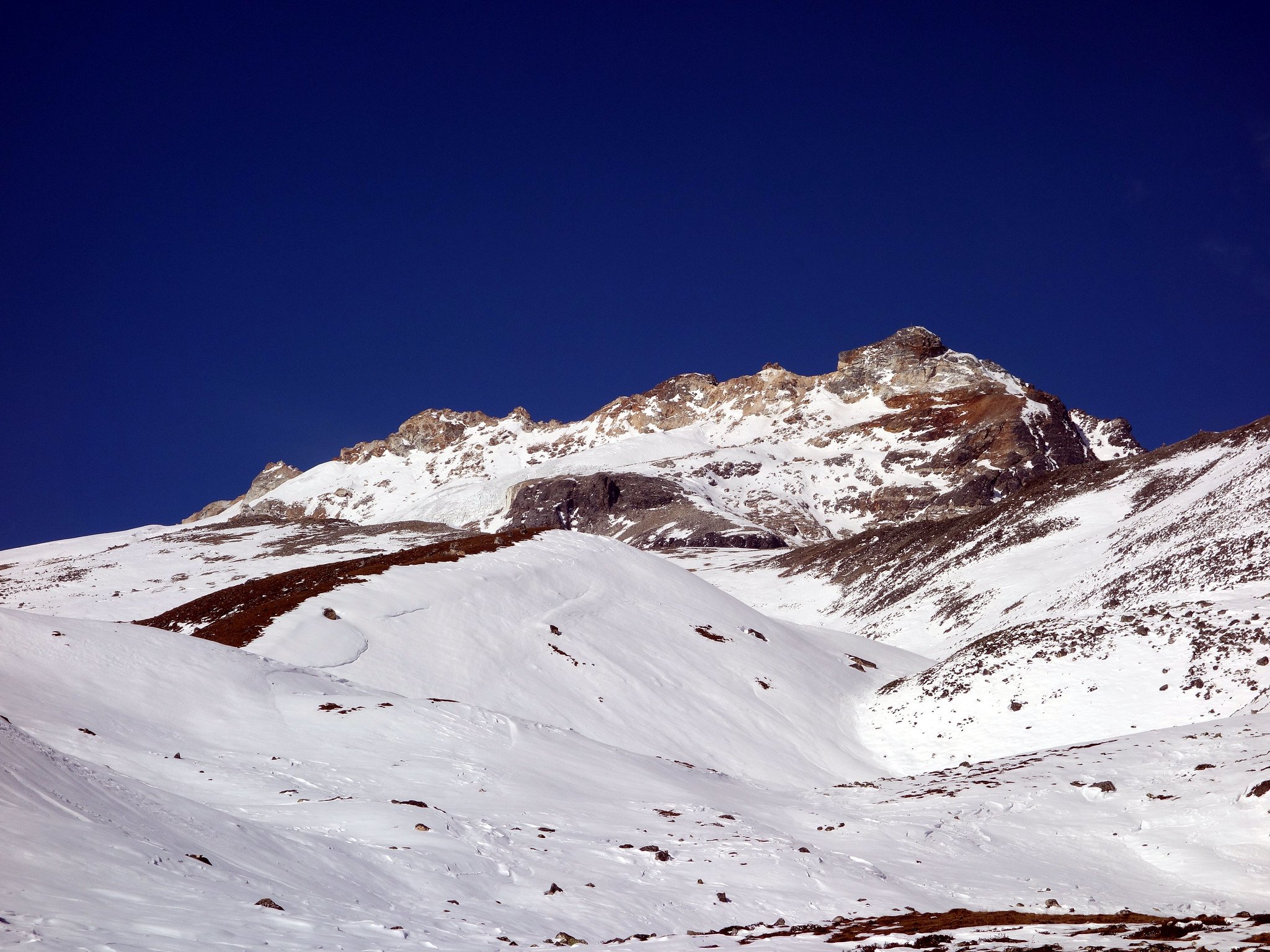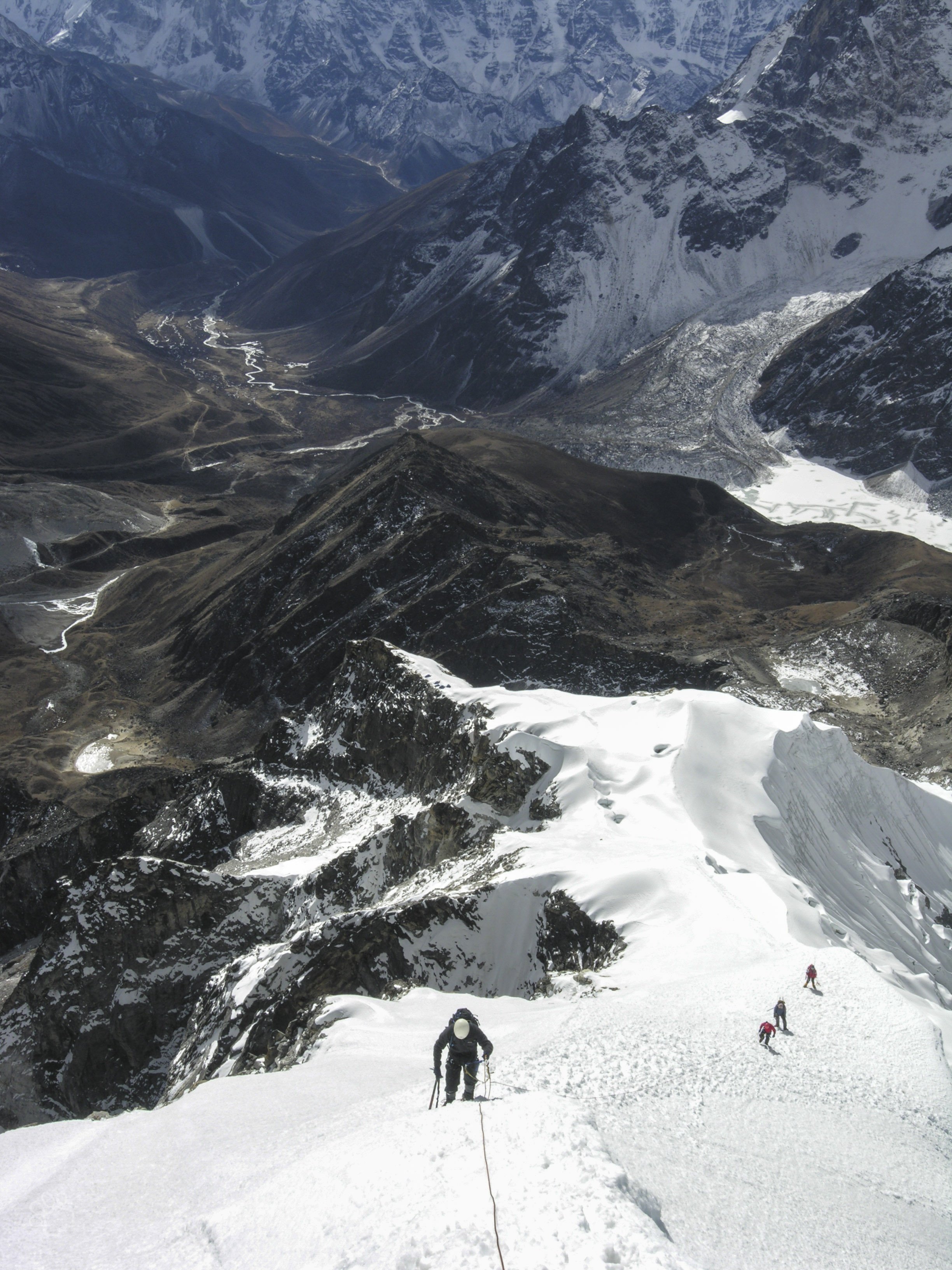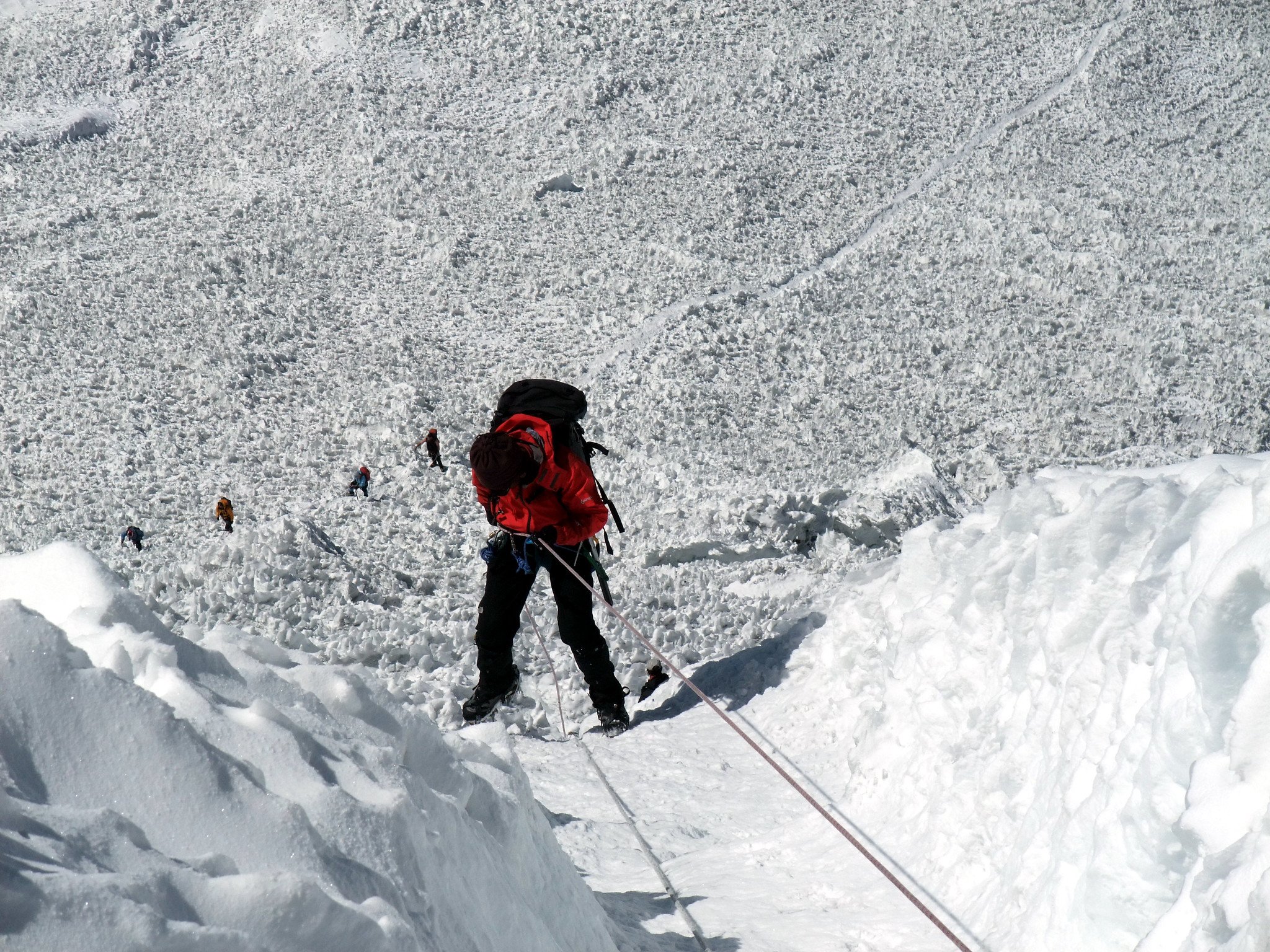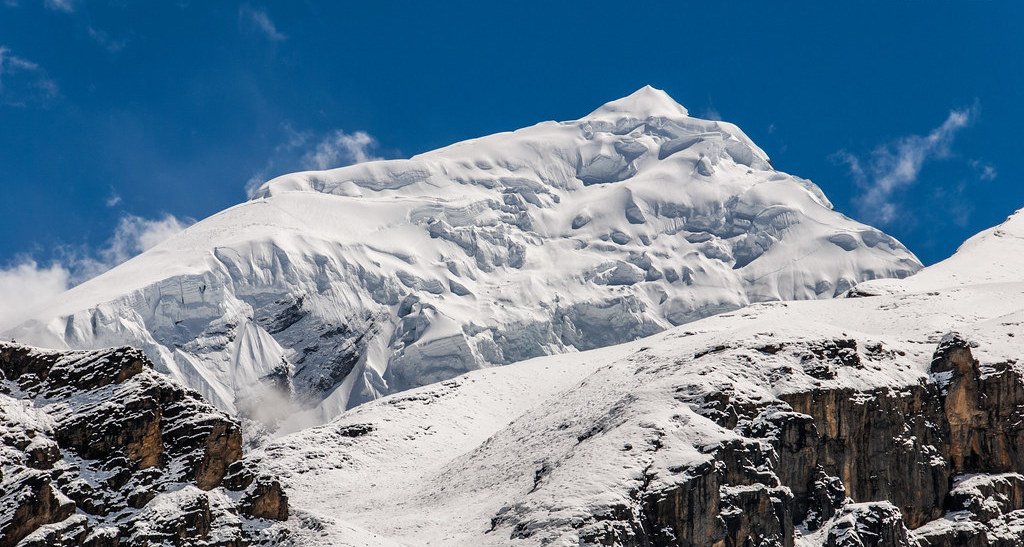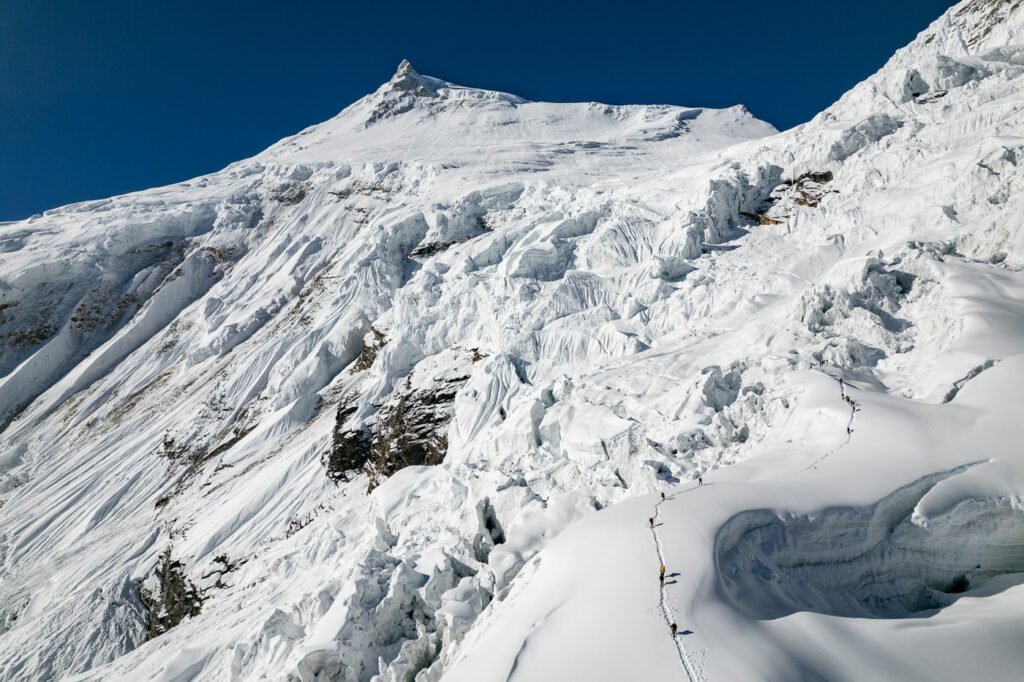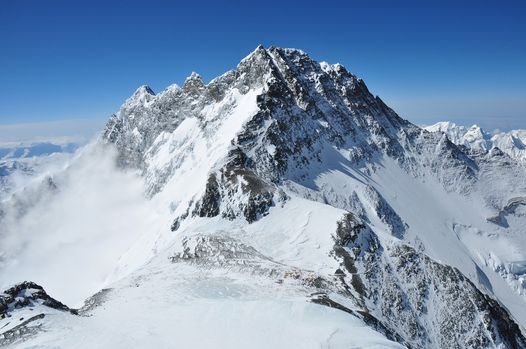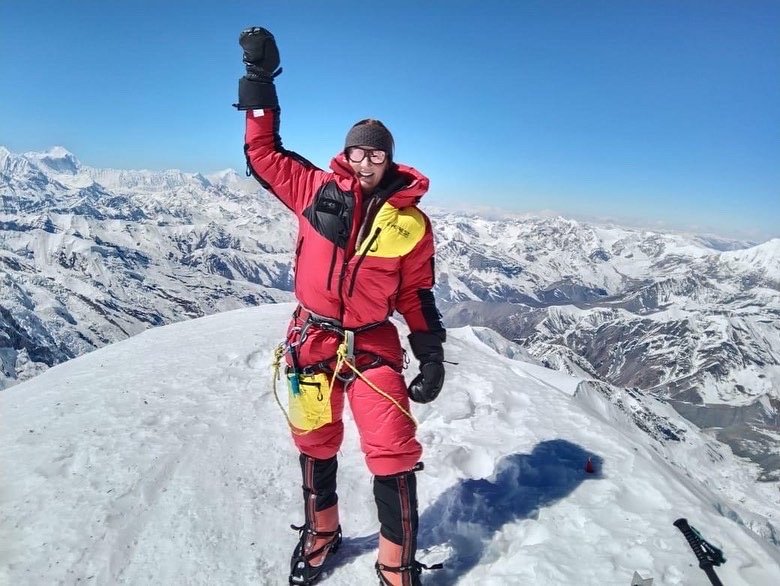Best 7000M+ peaks to climb in Nepal - Namas Adventure
Near the summit of Annapurna IV 7525M
Although 7000M peaks do not have the same level of prestige as 8000M peaks or the highest peaks in the world, they can still be a great challenge for adventure seekers. While these peaks may not be as well-known as their higher counterparts, they offer a unique and rewarding experience for climbers. 7000-meter peaks are ideal for those who are seeking a true adventure challenge, and who are motivated by a love of climbing, cultural immersion, and personal accomplishment. If you are one of these passionate climbers, consider embarking on a mountaineering expedition to one of the six 7000er peaks in Nepal listed in this post. These peaks offer a chance to push your limits and achieve something truly remarkable.
Below we have listed 6 amazing and remote peaks to climb in the Nepalese Himalayan range.
Note - Prior experience of alpine or mountaineering climb above 4000+M - 6000M+ is a must. Skill and fitness requirements will vary from different mountain peak objectives.
1. Himlung Himal 7126M (Least difficult & least technical 7000er)
Altitude: 7126M / 23,379ft
Climbers’ experience level: Intermediate/Advanced
Crowd level: Minimum (Spring, 5-20), Moderate (Autumn, 50 - 150)
Location: Annapurna Region
When to climb?: September - October
Duration: 30 Days
Difficulty grading: AD+/4 (Alpine/Fitness grading info)
Accommodation: Lodges and Base camp, Camp 1/2/3
Himlung Himal, standing at 7126 meters, is widely considered to be one of the safest and easiest 7000 meter peaks to climb in Nepal. Thanks to new, safer routes pioneered by French and Swiss climbers, Himlung Himal may become more accessible to climbers seeking a less technically demanding experience in western Nepal. The peak was not climbed until 1992, when it was conquered by a Japanese expedition, due to the fact that the area was not open to foreigners until the early 1990s. Located between the Manaslu and Annapurna ranges, the base camp for Himlung Himal is set up at an elevation of 4900 meters. The previous route up the peak, via the northwest ridge, has become increasingly prone to avalanche danger. A new, normal route was pioneered in 2013 by Kari Kobler of Switzerland, which offers an interesting and relatively short climb with limited objective danger. This route ascends the south flank of the northwest ridge to reach the upper crest, bypassing the previous route.
Note - Himlung Himal 7126M has the most successful summit records amongst all the 7000M+ commercial expeditions in Nepal. (Himalayan Database)
The Himlung Himal climbing expedition involves establishing 2-3 high camps at elevations of 5430 meters, 6000 meters, and 6300 meters. The summit day involves an ascent of 1100 meters through snow slopes with an angle of 40-45 degrees, requiring good snow conditions. Deep snow can pose a challenge even for strong teams. The climb is technically simple and objectively safe, making it an ideal preparation for your first 8000 meter peak.
History: First Ascent by the Japanese team in 1992.
Climb - Himlung Himal Link
2. Baruntse Peak 7129M (intermediate level and demanding)
Altitude: 7129M/ 23,389 ft
Acclimatization peak: Mera Peak 6476M
Climbers experience level: Intermediate level Experience
Crowd level: Minimum (Autumn, 15 - 40 climbers)
Location: Makalu Barun National Park
When to climb?: March-May or September - November
Duration: 32 - 35 Days
Difficulty Grading: D/ 4 (Alpine/Fitness grading info)
Accommodation: Lodges and Camping at Mera Peak/Baruntse BC/Camp 1 - 2
The Baruntse 7129M and Mera Peak 6476M climbing expedition offers a challenging and rewarding experience at the 7000 meter level. Baruntse, standing at 7129 meters, is located between Lhotse and Makalu, with other Himalayan peaks stretching out on either side. Teams often climb the nearby Mera Peak (6476 meters/21,246 feet) as an acclimatization climb, which falls on the same route as Baruntse. Once the base camp is established and the team has undergone training and a Puja ceremony, the real climb begins. Baruntse involves semi-technical climbing on steep slopes of 60 - 70 degrees incline to Camp 1 at 6000M via west col. The second camp is located at 6420 meters. Both camps are set up in exposed areas and are prone to high winds, so climbers should be prepared for unexpected weather conditions. The climbing route consists mainly of ice and snow, with very little rocky terrain after the first camp. Crevasses may appear more during the spring season compared to autumn along the route, and the objective at around 6900 meters can be dangerous. Experienced guidance is recommended in order to safely navigate the route to the summit.
History: Baruntse was first climbed on May 30, 1954 via the south ridge by Colin Todd and Geoff Harrow of a New Zealand expedition led by Sir Edmund Hillary.
Climb - Baruntse with Mera Peak Expedition link
3. Annapurna IV 7525M (advanced level, technical & physically demanding)
Altitude: 7525M / 24,688ft
Climbers experience level: Intermediate+/Advanced
Crowd level: Minimum (Spring/Autumn, 0 - 20)
Location: Annapurna Region
When to climb?: September - October
Total no of days: 33 Days
Difficulty grading: TD+/4 (Alpine/Fitness grading info)
Accommodation: Lodges and Base camp, Camps 1/2/3/4
Annapurna IV 7525M, is a great mountaineering objective for climbers looking for a challenging, but relatively safe and semi-technical climb. At 7527 meters, it is part of the Annapurna massif range and is located between Annapurna II and Annapurna III. While it may not be as popular as other peaks in the region, it offers fewer objective dangers and is considered the least technical of the Annapurna massif peaks (Annapurna I, II, III, IV, and Gangapurna). This mountain is not climbed as often as other peaks in the region.
History: Annapurna IV was first climbed in 1955 by a German expedition led by Heinz Steinmetz via the North Face and Northwest Ridge.
4. Tilicho Peak 7134M (intermediate level and remote climb)
Tiicho Peak 7134M.
Altitude: 7134M / 23,405ft ft
Climbers experience level: Intermediate to advanced
Crowd level: Minimum (Spring/autumn, 0-10 members)
Location: Annapurna Region
When to climb?: September - October-November
Total no of days: 32 Days
Difficulty grading: D+/4 (Alpine grading info)
Accommodation: Lodges and Basecamp, Camps 1/2/3
If you're seeking a technical challenge at the 7000M level, Tilicho Peak may be the climb for you. The expedition starts with a beautiful trek through the Annapurna circuit, culminating in a visit to Tilicho lake, the highest lake in the world, at an elevation of 4910 meters. Located in the Annapurna region of Nepal to the north of Manang, Tilicho Peak stands at a majestic 7134 meters. Its northeast ridge, covered in snow, towers over the Kali Gandaki valley to the west and the Marshyangdi Valley to the east, with the hidden kingdom of Mustang just a few miles to the north. The standard climbing route for the peak is the northwest shoulder, with the base camp located at 4910 meters on the northwest end of the lake.
Tilicho Peak is a technical climb that requires proficiency in climbing skills and physical fitness. It is recommended that climbers have previous experience in alpine and high-altitude climbing. The peak is graded as 4D, with a combination of rock and ice climbing, as well as glaciers. There are three high camps established on the route to the summit of Tilicho Peak. The climb from the base camp to Camp 1 at 5800 meters is straightforward, along a 50-degree mixed rock and ice route that is 590 meters in length. Camp 2, at 6200 meters, is located on the shoulder and can be accessed via a 55-degree snowfield that is 450 meters in length. The shoulder has an angle of 55 degrees and an 800-meter snowfield, with low objective danger and minimal exposure due to the wide width of the shoulder. Fixed ropes are required for the 40-degree slope to reach Camp 2 at 6300 meters. The summit is approached by climbing stretches of a 60-degree slope.
History: The first ascent was made in 1978 by the French climber Emanuel Schmutz using the northwest shoulder.
Climb - Tilicho Peak (Click here)
5. Putha Hiunchuli 7246M (Dhaulagiri VII) (least difficult and least technical. Remote 7000er)
Putha Hiunchuli (Dhaulagiri VII) 7246M, Photo by - Nunatak
Altitude: 7,246M / 23773ft
Difficulty: Least difficult and least technical
Crowd level: Minimum (Autumn, 5 - 20)
Location: Dhaulagiri Range
When to climb?: September - October
Total no of days: 31 Days
Difficulty grading: AD+/4 (Alpine grading info)
Accommodation: Lodges and Basecamp, Camp 1/2/3
Dhaulagiri VII (also known as 'Putha Hiunchuli') is one of the most accessible 7000M+ peaks in the Dhaulagiri range. It is located in the remote Dolpo or the wild west region of Nepal. Although most of the 7000M+ peaks are in remote corners of Nepal, this region even to locals is remotest compared to other regions of Nepal.
The climbing route has no significant technical climbing, the mountain is still a serious undertaking and provides excellent training for those who want to attempt Everest or other 8,000m peaks. Teams will be setting up three high altitude camps and a base camp. This can be considered as one of the easy climbs when we compare it amongst other 7000M peaks yet it is not to be underestimated. If you want to add an extra thrill then climbers with off-piste ski experiences can attempt a ski when descending.
History: This peak was first climbed by J.O.M Roberts and Ang Nima Sherpa in 1954.
Climb - Putha Hiunchuli (Dhaulagiri VII) Click here
6. Ama Dablam 6819M (advanced level & technical climb)
Altitude: 6,812M / 22,349ft
Acclimatization: Island peak 6180M
Climbers experience level: Advanced/Pro Level
Crowd level: Minimum (Spring, 5 - 20), Excessive (Autumn, 200 - 300) Mid October - Mid November is the busiest.
Location: Khumbu Region
When to climb?: September - November
Total no of days: 30 Days
Difficulty grading: TD+/5 (Alpine/Fitness grading info)
Accommodation: Lodges and Cam / Camping Island Peak BC/Highcamp/ Ama Dablam BC / Camp 1-2 and Camp 2.1 (depending on yearly climbing assessment)
Ama Dablam, standing at 6,856 meters, may not be as tall as some of the other 7000M peaks, but it is no less challenging. In fact, it is considered to be just as difficult as many of the 7000-meter peaks and is a must-do for alpine and mountain climbing enthusiasts. The combination of rock, snow, and ice climbing, along with exposed terrain and sections of almost 90-degree slopes, makes this peak a true test of skill and endurance. It is also known for its beauty and is highly sought after by even seasoned Everest summiteers. If you are looking for a thrilling and challenging mountain climbing experience, Ama Dablam is the peak for you.
Expedition teams normally utilize Island peak 6189M as an acclimatization peak before settling down at Ama Dablam base camp. The peak attracts a lot of climbers during the autumn season, rightly so because of its climbing nature. This expedition involves a cultural trek into the base camp and climbing on technical rock, vertical snow and ice routes and stunning exposed panoramic views of Everest, Lhotse, and Makalu from the summit. Teams climb Amadablam via the South West ridge, a technical route, and the standard route setting up 2 or possibly 3 camps (camp 3 depends on the assessment by each year’s rope fixing team). The route on the summit day is on steep snow and ice slopes, with outrageous exposure directly to the summit.
History: Ama Dablam was first summited on 13th March 1961, a Silver hut scientific expedition lead by Sir Edmund Hillary.
Climb - Ama Dablam with Island Peak Expedition (Link)
If you're looking to add some incredible mountain climbing experiences to your repertoire, consider tackling one of the 7000M+ peaks. Whether you're looking to build up to climbing even higher or just want the thrill of a mountaineering expedition, the peaks listed above offer some of the best mountain climbing adventures in the world. Located in remote areas and reaching high altitudes, each of these peaks has its own unique character and climbing challenges. We hope that these 7000M+ peaks will receive the recognition they deserve and that Nepal will continue to welcome mountain climbers from around the globe.
If you have any questions then there are some peaks like Baruntse, Ama Dablam, Tilicho Peak, Himlung Himal, and Annapurna IV expedition. We at Namas organize yearly departures but for other peaks such as Putha Hiunchuli, and Gangapurna upon inquiry our team will be able to organize a fully serviced expedition.
Go. Dare greater things.
Live Your Story.
Other related articles:
Climbing Baruntse 7129M Choosing the Right Route - Amphu Lhabtsa Pass 5800M or Mera Peak 6476M
Climbing Baruntse 7129M is an exhilarating high-altitude Himalayan experience. At Namas, our team of experienced climbers and expedition leaders is here to guide you in making an informed decision about the route to choose. With more than 5 years of leading expeditions to Baruntse peak in this article, we will delve into the unique features, advantages, and considerations of climbing Baruntse via Amphu Lhabtsa Pass or Mera Peak, helping you make an informed choice.
Climbing Baruntse via Amphu Lhabtsa Pass
The shorter 28-day itinerary offers an adventurous route via Khumbu & crossing over the Amphu Lhabtsa Pass at an elevation of 5800M. Here are some key highlights of this route:
Technical Challenge: Amphu Lhabtsa Pass is renowned as one of the most challenging passes in Nepal, demanding advanced climbing skills. Climbers will face zigzag glaciers, jumaring up the wall face, and scrambling/traversing rocky sections. The pass rewards climbers with breathtaking views of Imja Valley, Everest, Lhotse, Nuptse, Island Peak, Ama Dablam, and Baruntse.
Fatigueness: The Amphu Lhabtsa Pass itinerary allows climbers to reach Baruntse Base Camp with less fatigue, as they will have acclimatized during the challenging pass crossing. This can be beneficial for overall performance and enjoyment during the climb.
Climbing Baruntse via Mera Peak
For those opting for the longer 35-day itinerary, Mera Peak 6476M serves as an acclimatization/training peak. Consider the following aspects of this route:
Acclimatization: Climbing Mera Peak allows for gradual acclimatization and improves climbing skills. While Mera Peak is non-technical, it still requires physical stamina and endurance. Climbers will spend a night at the high camp situated at 5800 meters and make an early morning summit push to the Mera Peak summit at 6476 meters.
Fatigue considerations: Climbers should be aware that the Mera Peak climb is physically demanding, and they may feel tired and fatigued by the time they reach Baruntse Base Camp. Additionally, the camps between Mera Peak and Baruntse Base Camp have limited facilities, including food options. Some climbers may require additional rest days after the Mera Peak climb at Kongma Dingma.
Conclusion
When choosing the route to climb Baruntse 7129M, consider the technical challenges, acclimatization advantages, and personal preferences. Climbing via Amphu Lhabtsa Pass offers a shorter, adventurous route, while climbing via Mera Peak provides acclimatization benefits. At Namas, we are here to support you on your journey, ensuring a safe and memorable climbing experience. Make an informed decision based on your skills, fitness level, and desire for adventure. Prepare for an extraordinary expedition that will test your limits and reward you with stunning views and a sense of accomplishment in conquering Baruntse's majestic peak.
Let’s go climb Baruntse. Live Your Story
Ama Dablam Difficulty: How hard is Ama Dablam? - Namas Adventure
Ama Dablam (6810 meters) is considered a challenging mountain to climb, with a technical route that involves ice climbing, rock climbing, and high-altitude mountaineering. This expedition requires technical climbing equipment such as ropes, ice axes, crampons, ice screws, and cams and jumars. The rock climbing on the mountain can be rated at 4.11 to 5.7 - 5.10 in difficulty, while ice climbing is rated at WI3 - 4. It is important for climbers to have previous experience in both rock and ice climbing, as well as experience at high altitudes.
Ama Dablam DIFFICULTY GRADE: TD AND FITNESS LEVEL: 5.
(ALPINE / FITNESS GRADE LINK)
This expedition will require a high level of physical fitness, technical skill, and experience. With years of taking clients of different levels to the mountain, we can say the climb is difficult but not impossible. It is a physically and mentally demanding climb. Climbers with a deeper level of rock climbing will find it easier to adapt to the technical challenges of this expedition. It is a must that climbers have some experience at high altitudes before attempting to climb Ama Dablam.
Experience the thrill of climbing Ama Dablam, Island Peak, or Lobuche East with our team of experts. We offer a personalized, 1:1 guided expedition service to ensure that you have all the support and resources you need to succeed on your climb. Our all-inclusive service takes care of all your needs, so you can focus on reaching the summit.
Inquire at bookings@namasadventure.com or simply fill out our inquiry form.
How to prepare for Himlung Himal climbing expedition? - Namas Adventure
To climb any 7000M peaks, your pre-requisite previous experiences of climbing 4000M - 6500M+ semi/technical peaks are a must. ✅
Getting straight to the point, you can consider Himlung Himal as your first ever 7000M peak expedition. This will be a crucial extreme altitude climbing experience to progress into 8000M peaks or other technical peaks like Ama Dablam 6810M or Cholatse 6440M (more technical skills will also be needed, but we can make recommendations on that too). But yes, without a doubt Himlung Himal is a 7000M+ peak to climb if you are planning your first ever 7000er mountain peak. The climbing route at Himlung Himal is considerably safer and semi-technical in difficulty but like any high-altitude mountain expedition, you need to have a determined mindset, training preparation, and will to go on an adventure. Be ready for a long climb that will test you mentally and physically. Our team is there is motivate you and guide you to the summit (safely).
In this blog article, we will recommend prerequisite expeditions that will help you to be ready for Himlung Himal climb. This mountaineering experience is for everyone. (Yes, even if you have summited Everest, K2, or other tougher peaks). Mountain climbers are in love with the process of climbing, the journey, and not just the summits. If you are a novice/beginner climber, you are 1 or 2 climbing experiences (minimum) away, before taking on this beautiful climb. For experienced climbers; once you assess our recommendations below, should this expedition satisfy your next mountaineering adventure, then please get in touch with our team as we plan the Himlung Himal climb every year. (Spring/autumn).
Himlung Himal 7126M Expedition is for intermediate+ to pro experience level climbers. Now that you have an understanding of what it takes to climb this 7000M mountain, let’s start with our step-by-step expedition recommendations.
Step 1 (Novice level/Beginner Level) - Introduction to Mountaineering or Mera Peak 6476M
If you are an absolute beginner, who has never been to any previous high-altitude adventures trekking or climbing and you are inspired and dream of climbing extreme altitude mountains one day, then we can suggest these peaks, to begin with. With our team in Nepal, you can participate in our introductory expeditions to Introduction to Mountaineering - Yala Peak 5732M or Mera Peak 6476M to begin your mountaineering journey. This expedition’s objective will be to teach you the basics and fundamentals of mountaineering, test/expose yourself to any high-altitude environment on a non-technical peak climbing adventure in Nepal.
You will have to be in a good shape (run 5K, 2-3 times a week coupled with strength sessions) and upon completion, this experience will give you the confidence to climb other higher and semi-technical peaks.
Expedition Outcomes
Introduction and learn the basics of mountaineering
Learn the basics of mountaineering from certified local guides
High altitude experiences
Fun times in the mountains
Step 2 (Beginner + to intermediate level) - Lobuche East & Island Peak
At this level, you should have some kind of previous high altitude and exposure to mountain climbing. You have the understanding and experience of the fitness/mental level required when climbing high-altitude mountains. At this stage of beginner+ to intermediate level, you will further learn climbing at higher altitudes with some technical pitches. Meaning you will be re-introduced to all the previous basic climbing skills, adding further technical climbs. You will learn to navigate mixed rocky/snow/ice sections. Scramble/traverse on exposed sections and jumaring on the fixed-line rope to take on vertical sections of the mountains.
These skills are very necessary as you progress on your mountaineering journey and expeditions of this type will give you that extra confidence to take on other tougher and technically challenging peaks in the Himalayas or around the world. We recommend peaks such as Island Peak 6189M + Lobuche East 6019M, Khumbu Three Peak Expedition, Chulu West 6419M, and Three Peak Peru, expeditions for climbers at this stage. This expedition provides all the technical and physical challenges for climbers looking to progress at the Intermediate/+ level.
Expedition Outcomes
Introduction or Re-introduction to classic mountaineering climbs
Familiratisation with technical climbing gears
Climbing/scrambling/traversing in mixed section. (i.e- rock/ice/snow)
Experience climbing on exposed sections. (i.e. Ridge and couliors)
Jumaring in fixed-line to climb vertical sections.
Abseiling/Rappel several hundred feet down on fixed-line
Summits and small-scale expedition environment, tons of climbing fun
Step 3 (Intermediate to +/Advanced level)
At this stage, you are all ready for Himlung Himal Expedition. Like any mountaineering adventure, Himlung Himal climbing should not be underestimated. The climbing routes are well exposed starting after 6300M, as we climb the final ridge section of the mountain to reach the summit. Summit day is the longest during the whole expedition. With the assistance of your guide and attached to a fixed rope you, will be climbing uphill on the ridge slope section for an extended period of time and that also means a lot of abseiling while descending down the mountain. You will have to be mentally/physically ready and your confidence/experience/patience is super key.
7000M expedition of this nature will test you. Your previous knowledge of climbing/traversing/abseiling in the exposed mixed section will be put to further test. There will be two high alpine camps and colder/longer days at higher altitudes. You are constantly exposed to the forces of nature and challenged mentally/physically for an extended period of time compared to your previous expeditions. The climbing route is faced on the west side, hence the sun only hits the slopes in the later part of the day, resulting in a colder climbing condition.
The final summit push day will be longer, more demanding, tougher, technically, physically, and mentally challenging than your previous camps. You will also have to learn how to co-operate as a team, there may be some weak links in the team so you will have to adjust, and understand how grouped expedition runs, allowing everyone to achieve the same goal of summiting a 7000M peak.
Expedition outcomes
Developing climbing skills at 7000M level.
Understanding of full expedition setups
Climbing/scrambling/traversing in mixed section. (i.e- rock/ice/snow) at higher altitudes above 6000M.
Longer exposure to climbing on exposed sections. (i.e. 6300M steep ridge to the summit)
Jumaring in fixed-line to climb vertical sections.
Abseiling/Rappel in longer and exposed ridge sections.
Testing your physical and mental ability and pure grit at extreme altitudes.
Summits and climbing moments at 7000M level
Bonus - Step 2. 1 even 8000ers or Pro level climbers (Grades TD+)
This is a bonus step. Many experienced climbers are attracted to the remoteness and challenge of climbing Himlung Himal. Even after completing 8000er peaks like Everest, Manaslu, Makalu, K2, and Ama Dablam climbers return to enjoy the climb at this 7000M peak. So if you have done 8000M peaks then you are 100% qualified for HH expedition. You will already have an understanding of big mountain expeditions and what it takes to climb challenging mountains.
Will this Himlung Himal 7126M expedition help me to climb 8000M mountain peaks?
Most certainly YES. Many climbers skip this crucial experience of climbing, experiencing, and testing themselves at 7000M+ extreme altitudes. No amount of reading knowledge surpasses your personal experiences. Also, the benefit of climbing 7000M is that not only does it challenge you to prepare for 8000M peaks like Manaslu 8163M or Broad Peak 8051M but its charm is in its remoteness and not many climbers are there to attempt the climb. So, you preety much have the whole of the mountain to your group or let’s say you can avoid the traffic.
Himlung Himal expedition is a very achievable mountaineering objective so the question remains. Are you ready for this Himalayan adventure?
Planning to climb Himlung Himal 7126M or simply a 7000M peak? You do not have the right experiences or need help preparing for 7000M climbs? Our team is here to understand your goals and help you plan strategically with the right experiences. Please go through our Alpine /fitness grades (link) to understand the difficulty and climbing grades of Himlung Himal and other peaks. We hope the guidance and suggestion on this blog post have helped you to have an understanding of what it takes to climb this amazing 7000M peak. There are a lot of other factors when climbing any extremely high altitude semi-technical peaks in the Himalayas. Our team can help you prepare in the best way gaining the right experience to complete your dream of climbing Himlung Himal 7126M peak.
A 7000er is a beautiful climb that will remain in your memories forever. Let’s go and climb this remote peak in the Shadow of Manaslu and Annapurna massif ranges.
Namas Adventure Team
Live Your Story
Himlung Himal Expedition (Experience, fitness level and skills) requirements - Namas Adventure
What previous experience is required to climb Himlung Himal?
When planning a Himlung Himal expedition, it is important to consider your previous climbing experience. This 7000M+ peak presents a number of challenges, including the need for comfort and experience with ropes, climbing gear, and fixed-line techniques, as well as the ability to withstand cold and potentially adverse weather conditions.
While Himlung Himal may not be the most technically demanding of the 7000M peaks in Nepal, it is still a significant undertaking that requires a strong level of skill and preparedness. If you have limited climbing experience, this peak may be a good option to start your journey into 7000M+ expeditions. Its relatively high success rate and the fact that it requires the use of gear and fixed lines make it a suitable choice for those looking to build their skills and confidence. Regardless of your level of experience, it is crucial to be physically and mentally prepared for the demands of this expedition.
Preferred Previous mountaineering experiences
Anywhere above 4000M - 6500M+ peaks with semi-technical to technical climbs around the world. For example Alpamayo, Huscaran, Aconcagua, Kilimanjaro, Mt. Kenya, Denali, Mt. Blanc, Mt lenin, Ebrus. The general term is any semi-technical to technical peaks that are higher and have longer ascend and descend sections. These experiences do qualify you to take on Baruntse and other 7000M peaks in the Himalayas.
Fitness level - 4
We have graded fitness level 4 for Mount Himlung. An exceptional level of all-around fitness will be required to cope with the exceptionally strenuous nature of these expeditions. An exceptional level of endurance and strength fitness level is required. The mental toughness aspect is equally required. Experience is required to be able to take on tours of this physical grading.
The difficult issue is how you train for such exceptional conditions. Hard work will be required to get to that fitness level. For a General fitness indication, climbers should be able to run a half marathon or be able to cycle for 2 -3 hours. If you prefer hiking, you should be able to carry a load of 20 kilograms and hike for 3 to 4 hours.
Good strength and muscle endurance training routines can be implemented with a variety of approaches such as taking part in cross-fit sessions and kettlebell training.
Skills to be learned.
Guides in Nepal will advise you to keep it real simple. So there are four basic things you must - must know.
Figure 8 knot and how to tie a stopper knot at the end of the rope.
Ascending/jumaring on fixed-line and abseiling with super 8 belay device or ATC descender in multi-pitch sections. You will have to be very very careful and well-rehearsed on abseiling since there is no room for errors when descending. You only get that one chance when coming down so you will have to be super careful. And for safety backup have ‘prusik knot’ tied on the main rope.
Climbing, traversing, and hiking with crampons on for long-duration on ice, rock, and snow surface.
Performing snow arrest and safely getting back up if by any chance climbers slip and slide.
As climbers joining Himlung Himal expedition will already have previous experiences, we recommend climbers to have extra essential skills in their climbing arsenal. If you cant find mountains to climb near your place, rock climbing indoors and outdoors is one of the best ways to keep refreshing your rope skills and staying in climbing shape.
With all commercial expeditions, the majority of your expedition is handled and taken care of by your expedition company. Having competent members from operational management to guiding leaders on the field is key for any successful expedition. Once you are signed up and you’ve got the necessary skills and experience all you need to be is physically and mentally prepared that is your commitment to fitness training.
Challenge yourself.
Go. Live Your Story
Are you planning to climb a remote, rugged, and challenging 7000M+ peak with substantially less objective danger? Whether your goal is simply to climb an extremely high altitude peak, explore and climb remote peaks in Nepal, or progress to higher 8000M+ peaks then our team at Namas Adventure/Expedition is set for your next adventure. Email - bookings@namasadventure.com or Call/Whatsapp us at +447446976060 and our team will be there to answer your inquiry and instruct you with any questions regarding the expedition.













